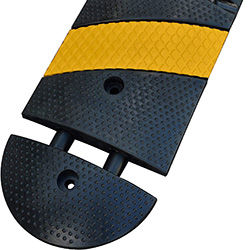Definition of Speed Reducers
Speed reducers, also known as traffic calming devices or speed bumps, are physical structures placed on roads or streets to slow down vehicle speeds. They are typically made of durable materials such as concrete or asphalt and are designed to withstand the weight and impact of vehicles. Speed reducers play a crucial role in high-pedestrian areas by reducing the speed of vehicles, which helps to enhance pedestrian safety and improve overall traffic flow. These devices are often marked with stripes or reflectors to increase visibility and alert drivers to slow down.
Importance of Speed Reducers in High-Pedestrian Areas
Speed reducers play a crucial role in ensuring the safety of pedestrians in high-pedestrian areas. These areas are often characterized by heavy foot traffic, making it essential to control vehicle speeds. By slowing down vehicles, speed reducers create a safer environment for pedestrians, reducing the risk of accidents and injuries. Additionally, speed reducers help to improve the overall traffic flow in these areas by promoting a more orderly and controlled movement of vehicles. This is especially important during peak hours when congestion is common. Overall, the installation of speed reducers is vital for prioritizing pedestrian safety and enhancing the efficiency of high-pedestrian areas.
Benefits of Speed Reducers
Enhanced Safety for Pedestrians
Speed reducers play a crucial role in enhancing safety for pedestrians in high-pedestrian areas. By forcing vehicles to slow down, speed reducers create a safer environment for pedestrians to cross the road. Pedestrians can feel more confident and secureknowing that vehicles are traveling at reduced speeds. Additionally, speed reducers act as visual cues for drivers, reminding them to be cautious and watch out for pedestrians. This helps to prevent accidents and promotes a culture of pedestrian safety. Overall, the presence of speed reducers significantly reduces the risk of pedestrian accidents and improves the overall safety of high-pedestrian areas.
Reduced Vehicle Speeds
One of the key benefits of speed reducers in high-pedestrian areas is the reduction in vehicle speeds. By implementing speed reducers such as speed bumps or speed humps, drivers are forced to slow down, creating a safer environment for pedestrians. This reduction in vehicle speeds significantly decreases the risk of accidents and injuries. Additionally, slower vehicle speeds also contribute to a more peaceful and pleasant atmosphere in busy pedestrian areas, allowing people to feel more comfortable and relaxed while walking.
Improved Traffic Flow
One of the benefits of using speed reducers in high-pedestrian areas is improved traffic flow. By reducing vehicle speeds, speed reducers help to create a more controlled and orderly traffic environment. This can lead to a smoother flow of vehicles, minimizing congestion and delays. Additionally, speed reducers can help to prevent sudden stops and starts, which can further improve traffic flow. Overall, the implementation of speed reducers in high-pedestrian areas can contribute to a more efficient and seamless transportation system.
Proper Installation Techniques
Proper installation techniques are crucial for the effectiveness of speed reducers in high-pedestrian areas. Attention to detail is key when it comes to installing speed reducers to ensure their functionality and durability. It is important to follow manufacturer guidelines and specifications for the correct placement and alignment of the speed reducers. Additionally, proper anchoring and fastening of the speed reducers is essential to prevent any movement or displacement. Regular inspections should be conducted to identify any signs of damage or wear, and necessary repairs or replacements should be carried out promptly.
Regular Maintenance and Inspection
Regular maintenance and inspection of speed reducers is crucial to ensure their optimal performance and longevity. This involves conducting routine checks to identify any signs of wear and tear, such as cracks or uneven surfaces. Additionally, it is important to clean and lubricate the speed reducers regularly to prevent debris buildup and ensure smooth operation. Proper maintenance not only extends the lifespan of the speed reducers but also helps in identifying potential issues early on, allowing for timely repairs or replacements. Implementing a comprehensive maintenance plan and adhering to it can significantly enhance the effectiveness and reliability of speed reducers in high-pedestrian areas.
Conclusion
Speed reducers have proven to be highly effective in improving safety and reducing accidents in high-pedestrian areas. By slowing down vehicle speeds, speed reducers create a safer environment for pedestrians, reducing the risk of collisions and injuries. Additionally, speed reducers help to improve traffic flow by encouraging drivers to drive at a more controlled pace. The installation of speed reducers, combined with regular maintenance and inspection, ensures their continued effectiveness in high-pedestrian areas.
As technology continues to advance, speed reducer technology is also expected to evolve. One of the future trends in speed reducer technology is the development of smart speed reducers. These speed reducers will be equipped with sensors and connectivity features, allowing them to collect data on vehicle speeds, pedestrian movements, and traffic patterns. This data can then be used to optimize the performance of speed reducers and improve overall traffic flow. Additionally, there is a growing interest in developing eco-friendly speed reducers that are made from sustainable materials and have minimal impact on the environment. These advancements in speed reducer technology will further enhance the effectiveness of speed reducers in high-pedestrian areas, ensuring the safety and convenience of pedestrians and motorists alike.


